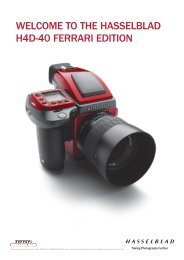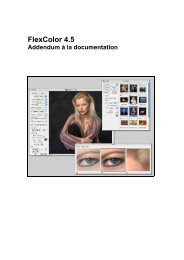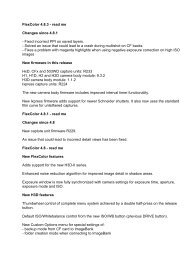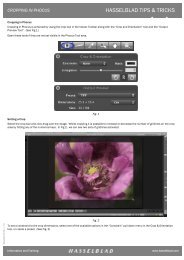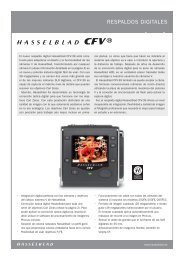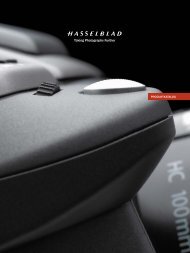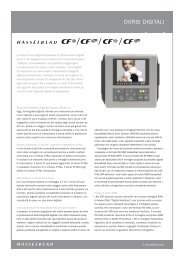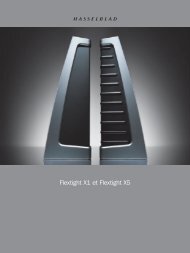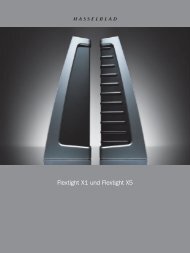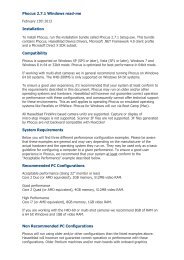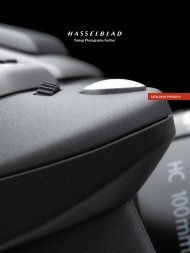tAking pHotogrApHY furtHer - Hasselblad
tAking pHotogrApHY furtHer - Hasselblad
tAking pHotogrApHY furtHer - Hasselblad
- No tags were found...
Create successful ePaper yourself
Turn your PDF publications into a flip-book with our unique Google optimized e-Paper software.
HASSELBLAD IMAGE QUALITY. Three simple words that represent over50 years of imaging expertise. That represent what is widely regarded asthe industry’s most uncompromising standards. Three simple words thatstand for a level of technical achievement that has helped photographerspush the photographic envelope for over half a century. We know whatthe words stand for – the question is, what stands behind them?In addition to the over 50 years ofR&D, to the feedback and input ofthe world’s best photographers, engineers,and designers, there are a fewbasic components that are requiredto produce the unparallelled <strong>Hasselblad</strong>level of digital quality found inour current camera systems.First, the combination of theworld’s most advanced optical system,in the form of medium-formatlenses and the HC/HCD large formatdigital lenses, with the world’sleading sensors, like those found inour 31, 39, and 50 megapixel products.Second, the extremely highlevel of system integration foundin the H3DII cameras, which guaranteesoptimum physical, electricaland digital operation, allowing youto squeeze maximum performanceand image quality from every linkin the photographic chain. Thirdly,the benefits gained from our patentedcamera component designs andcentral shutter lenses. And finally,the power of our Phocus softwareand RAW converter, enabling evenfurther image enhancements andcorrections. Together, these componentsform the foundation ofHasselbald Image Quality.What DefinesUltimate DigitalImage Quality?Ultimate digital image quality is theresult of five basic parameters: Resolution,Natural Color, Optical Purity,Clarity, and Detail. Each play a keyrole in achieving superior image quality.Each parameter, alone – or a pair,or three – can improve image quality,but to achieve ultimate image quality,photographers need a system thatexcels in all five of these areas.The <strong>Hasselblad</strong> H System is theonly camera system on the markettoday that can provide exceptionalperformance in all five areas. Andat <strong>Hasselblad</strong> we are constantly focusingon further improving ourperformance in these areas – strivingfor perfection and never accepting“good enough” – in order to pushthe image quality envelope evenfurther.Resolution isWhere It StartsMost photographers understand that“Bigger” is still “Better” in manyways. The larger and more opticallyperfect your lenses are, for instance,and the larger your digital sensorand the larger the number of pixelsit contains, the more resolution yourimages will contain. The higher thedefinition of your images, the moredetail, the lower risk of moiré andother artifacts, and the more accurateyour colors will.What You See IsRarely What YouGetIn the past, the colors you saw beforeyou when you took your shot wererarely the colors captured by yourcamera. Color management solutionshave attempted to remedy thisproblem, but have imposed ratherdrastic limitations on professionaldigital photographers, forcing themto choose a specific color profile tosuit each specific job and therebysacrificing some colors to get othersright. This is an unacceptablesolution, in our opinion. That’s whywe developed the <strong>Hasselblad</strong> NaturalColor Solution.The <strong>Hasselblad</strong> Natural ColorSolution accurately reproduces thefull visible color spectrum – be itskin tones, special product colors,or difficult gradations – easily andeffectively, every time and with theuse of a single color profile. Ourcomplete knowledge of the filterand sensor characteristics of eachindividual <strong>Hasselblad</strong> camera modelhas made it possible for use to ensurethat the colors you see are the colorsyour get. With no compromises andno mistakes. A simple, correct, andindispensable solution to a longstandingproblem.Nothing’s EverPerfect – ButThat Doesn’t StopUs From TryingEven the finest of optics falls shortof perfection. And in falling short,they cause certain minor errors inyour final images. The H System’ssophisticated and unique DigitalAuto Correction (DAC) uses the extensiveinformation about the lensand exposure data collected in theRAW file to correct even the slightestoptical errors. The camera notonly records the lens type, exposurespeed, aperture and focal length inevery exposure, but also the range atwhich the picture was taken. Later,when processing the digital imagesin Phocus, you can decide whetheror not to correct vignetting, distortionand lateral chromatic aberrationbased on this information, bringingthe quality of your images that muchcloser to perfection.Getting YourLight BackVignetting, or light fall-off towardsthe edges of an image, is caused bya number of things. One is that rearlens elements are shaded by the elementsin front of them. Another isthat sensor wells are better at pickingup light when the light beam isperpendicular to the sensor, whichis more the case in the middle of animage than at the edge. <strong>Hasselblad</strong>’sDAC III removes this effect and givesyou the ability to shoot even wideangle images with evenly distributedlight, with illumination from thecenter to the edge, which can beof particular use when you want tostitch images.Optical PurityCorrecting for distortion, chromaticaberration, and noise is also a tricky,but necessary science. Distortion,for instance, is a minor problemfor most, but often difficult to fixwhen not wanted. And while mostchromatic aberration is removed bythe lens design, some does remain.However, removing it completely,if possible at all, would cause otherproblems like reduced light sensitivity,as well as heavier and much morecostly lenses. Remaining chromaticaberration is not usually apparentunless an image is at high zoom, buteffects can sometimes be seen on finalprints. The <strong>Hasselblad</strong> H Systemuses the information contained in<strong>Hasselblad</strong> RAW files to automaticallycorrect both chromatic aberrationand distortion with a click of a buttonif you desire.Finding optimal noise reductiontechniques is also difficult, but requiredwhen shooting at high ISO orwith long exposure times. Findingthe proper balance between preservationof detail and clarity andthe removal of unwanted static or“noise” from an image requires anunderstanding of both technologyand of photography. The high qualityof <strong>Hasselblad</strong>’s optical componentsand the advanced noise reductiontechniques achieve an optimum balancebetween desired richness ofdetail and noise-free imaging.The Truth is inthe DetailsIt’s the details that help you discoverexactly what your optics anddigital sensor can really capture. Thecombination of the market’s largestsensors and outstanding opticsfound in the <strong>Hasselblad</strong> H3D ensuresthat your details really stand out.Even when comparing images shotwith the most advanced, high-endproducts, there is a clear differencein the results that are achieved fromthe different approaches available.Compare for yourself and see the differencethat the <strong>Hasselblad</strong> approachbrings.The <strong>Hasselblad</strong> raw processor,working on the 3FR raw image for-mat, is the best processor availableand allows you to accurately reproducethe finest of details. Detailssuch as single hair strands, smallcolored patterns, fine text, and so on.Details that have proven too difficultfor even the most advanced digitalsystems. With the H3D, you can restassured that every detail is preserved– and nothing is sacrificed.Moire Be Gone!Phocus also plays an important rolebecause of its sophisticated moirétool. Most 35 mm camera use aso-called antialiasing filter, but inpractice, this filter is nothing otherthan a blur filter mounted beforethe sensor. This prevents the camerafrom misinterpreting the tinydetails that overpower the sensor’sresolution into ugly looking colorpatterns and edges, but also lowersthe effective resolution of the camerasystem as a whole, requiring youto later sharpen the image in postproduction.The advanced moiré tool in Phocus,on the other hand, identifiesthe affected area and rids the pictureof aberrations in a targeted manner,without touching unaffected parts ofthe image. Phocus even allows you tosave the corrected and uncorrectedversions of the image in differentlayers of a PSD-file, giving you totalcontrol over moiré reduction withinPhotoshop.You Don’t Missthe Quality Untilyou Don’t Have ItUltimately, you never know howmuch quality or detail you need inan image until long after you’ve leftthe shoot. The amazing detail andresolution of <strong>Hasselblad</strong> files lets yourest easy, enabling your to changethe aspect ratio or crop the image asneeded at a later date, without losingthe quality needed for the job.8 Special/2008




